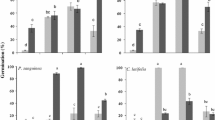Abstract
Two 60-day experiments were conducted to study the influence of photon flux density (PFD) and temperature on the attachment and development of Gloiopeltis tenax and Gloiopeltis furcata tetraspores. In the first experiment, tetraspores of the two Gloiopeltis species were incubated at five temperature ranges (8°C, 12°C, 16°C, 20°C, 24°C) under a constant PFD of 80 μmol photons m−2 s−1 with a photoperiod of 12:12. In a second experiment, tetraspores were incubated under five PFD gradients (30, 55, 80, 105, 130 μmol photons m−2 s−1) at a constant temperature of 16°C with a photoperiod of 12:12. Maximum density of attached tetraspores was observed at 16°C for both species. Maximum per cent of spore germinating into disc was recorded at 12–16°C for G. tenax and 8–12°C for G. furcata. Maximum per cent of discs producing erect axes for G. tenax and G. furcata were recorded at 24°C and 20°C, respectively. Light had no significant effect on tetraspore attachment and developing into disc, but it affected the growth, sprouting and survival of its discs. Under 30–55 μmol photons m−2 s−1, the discs of the two species of Gloiopeltis did not form thallus until the end of the experiment. Optimum PFD range for G. tenax discs was 80–105 μmol photons m−2 s−1, whilst it was 80–130 μmol photons m−2 s−1 for G. furcata. Results presented in this study are expected to assist the progress of artificial seeding of Gloiopeltis.



Similar content being viewed by others
References
Chen S, Wu J, Chen L, Liu T (2008) Pilot study on indoor cultivation of two species of Gloiopeltis mature and spore release. S China Fish Sci 4(2):1–5
Jung YH, Jung BM, Shin MO, Bae SJ (2006) Anticarcinogenic effects of extracts from Gloiopeltis tenax. J Korean Soc Food Sci Nutr 35:395–401
Kinosita T (1942) A new propagation method of Gloiopeltis. Nippon Suisan Gakkaishi 11:1–4
Ren DL, Wang J, Noda H, Amano H, Ogawa S (1995) The effects of an algal polysaccharide from Goliopeltis tenax on transplantable tumors to immune activities in mice. Planta Med 61:120–125
Suto S (1948a) On a method of “sowing” the spores of an alga of commercial value, Gloiopeltis tenax, on the rocky shores. Nippon Suisan Gakkaishi 15:226–228
Suto S (1948b) On the paraspores in some species of Gloiopeltis. Nippon Suisan Gakkaishi 14:87–89
Suto S (1948c) Shedding, floating and fixing of the spores of Gloiopeltis. Nippon Suisan Gakkaishi 14:184–188
Suto S (1957) Cultivation of Gloiopeltis. Suisangaku shuisei. Tokyo University Press, Tokyo, pp 819–828
Tseng CK (1983) Common seaweeds of China. Science Press, Beijing, 94 pp
Tamura T (1960) Proliferation of Gloiopeltis. Shallow sea proliferation study. Koseisha Koseikaku Press, Tokyo, pp 303–306
Wu J, Chen S, Chen L, Lv G (2007) Preliminary ecological study on seaweed Gloiopeltis in coast of Guangdong province. S China Fish Sci 3(5):7–13
Yin M, Hu X, Ci T (2007) Filament formation and differentiation in seven species of red algae. Bot Mar 50:113–118
Yu J, Xu Z, Yan L, Cheng S (2007) Studies on the anti-mutagenic and anti-tumor effects of the polysaccharide of Gloiopeltis furcata. J Shantou Univ 22:59–63
Zeng C (1984) Phycological research in the development of the Chinese seaweed industry. Hydrobiologia 116–117:7–18
Zhang Z, Han Y, Li X, Sato Y, Li X (2009) Reproductive biology and indoor cultivation of seaweed Gloiopeltis tenax. J Dalian Fish Univ 24:1–7
Acknowledgement
This work was supported by the Basic Research Operation Fee Program of Research Institute of Chinese Commonweal property of South China Sea Fisheries Research Institute, Chinese Academy of Fishery Sciences (2007TS01). It was also supported by the Technology Project Program of Guangdong Province and Fishery Technology Popularization Program of Guangdong Province (2006B20201061, A200899E01).
Author information
Authors and Affiliations
Corresponding author
Additional information
Jinfeng Wu contributed equally to this work.
Rights and permissions
About this article
Cite this article
Chen, S., Wu, J., Chen, L. et al. Effects of light and temperature on the attachment and development of Gloiopeltis tenax and Gloiopeltis furcata tetraspores. J Appl Phycol 23, 1045–1051 (2011). https://doi.org/10.1007/s10811-010-9638-z
Received:
Revised:
Accepted:
Published:
Issue Date:
DOI: https://doi.org/10.1007/s10811-010-9638-z




